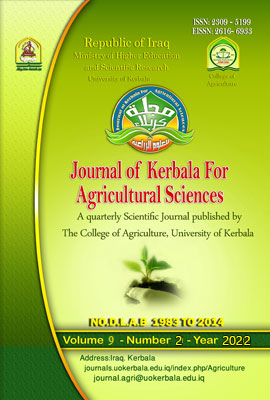Effect of partial replacement of raw and treated wheat bran with hydrochloric acid, ascorbic acid and bakery yeast for wheat in broiler diets on production performance
DOI:
https://doi.org/10.59658/jkas.v9i2.963Keywords:
ascorbic acid, bakery yeast, broiler chickens, HCL acid, wheat branAbstract
The present study was aimed to investigate the effect of partial replacement of raw wheat and treated by HCL, bakery yeast (Saccharomyces cerevisiae), and ascorbic acid instead of wheat on broiler productivity. A total of 405 two weeks old of unsexed Ross 308 of broiler chicks were used in the experiment ,distributed randomly to nine treatments ,the chicks were fed on two rations ,grower and finisher rations . The results revealed that the treatments included wheat bran of treated (with 25% replacement )showed no significant differences as compared to control group in live body weight ,weight gain ,at 42 days of age. Also, there were a significant increase (P >0.01) in the feed intake at (3-6) weeks in favor of (T4) and (T7) compared with the control treatment (T1). Most of the replacement treatments achieved a significant improvement in the feed conversion ratio. no significant differences for all treatments in the dressing percentage and the relative weight of the breast piece. Also, no significant differences appeared in the percentage of mortality, while most of the replacement treatments gave very good economic indicators and production indexes.
Downloads
Published
How to Cite
Issue
Section
License
Copyright (c) 2022 Copyright (c) 2024 is the Author's article. Published by the Journal of Kerbala for Agricultural Sciences under a CC BY 4.0 license

This work is licensed under a Creative Commons Attribution 4.0 International License.
Licensing Terms
All articles are published under a Creative Commons License and will be directed to the Creative Commons Attribution 4.0 International License (CC BY 4.0) That permits use, distribution, and reproduction in any medium, provided the original work is properly cited. This license also allows the work to be used for commercial purposes.
Use by both non-commercial and commercial users
This content is licensed under a Creative Commons Attribution 4.0 International (CC BY 4.0) license, permitting use by both non-commercial and commercial users. Individual users may access, download, copy, display, and redistribute the articles to colleagues, as well as adapt, translate, and text- and data-mine the content, subject to the following conditions:
- The author's moral rights, including the right of attribution and the right to protect their work from derogatory treatment, are respected.
- Where content in the article is identified as belonging to a third party, users must ensure that any reuse complies with the copyright policies of the owner of that content.
- If the article content is reused for research or educational purposes, users should maintain a link to the appropriate bibliographic citation, including the DOI and a link to the published version on the journal's website.

